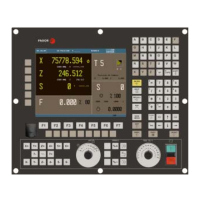·636·
Installation manual
CNC 8055
CNC 8055i
17.
PLC PROGRAMMING EXAMPLE
SOFT: V02.2X
Main module.
----- Treatment of the machine reference (home) switches -----
I-REF0X = DECEL1
I-REF0Y = DECEL2
I-REF0Z = DECEL3
----- Message treatment -----
The PLC allows displaying the corresponding PLC message at the CNC screen by activating marks
MSG1 through MSG255. This text must be previously edited at the PLC message table.
The following example shows how to generate a message to remind the operator to home the axes
after powering the machine up.
(MANUAL OR MDI OR AUTOMAT) AND NOT (REFPOIN1 AND REFPOIN2 AND REFPOIN3) =
MSG5
The message (MSG5) appears in the JOG, MDI or Automatic modes and only when the axes of
the machine have not been referenced (homed). The CNC logic outputs "REFPOIN" indicate that
the axes have been homed. ----- Error treatment -----
----- Error message treatment -----
The PLC permits displaying the corresponding error message on the CNC screen by activating
marks ERR1 through ERR128 as well as interrupting the CNC program execution stopping the axes
and the spindle. The activation of any of these marks does not activate the external CNC Emergency
output.
Because the PLC program is not interrupted by these marks, it is advised to make it possible to
change their status via accessible external inputs; otherwise, the CNC will keep receiving the same
error at every PLC scan (cycle) thus preventing access to any PLC mode.
The text associated to the error message must be previously edited at the PLC error table.
The next example shows how to generate the X axis overtravel limit overrun error when one of the
overtravel limit switches is pressed.
NOT I-LIMTX1 OR NOT I-LIMTX2 = ERR10
----- Treatment of M, S, T functions -----
The CNC activates the general logic output MSTROBE to "tell" the PLC to execute the M functions
indicated at the variables MBCD1 through MBCD7.
It also activates: the SSTROBE output when the S function indicated at variable SBCD must be
executed, the TSTROBE output when the T function indicated at variable TBCD must be executed
and the T2STROBE output when the T function indicated at variable T2BCD must be executed.
Whenever the CNC activates one of these signals, it is convenient to deactivate the general CNC
input AUXEND in order to interrupt the execution of the CNC. When the PLC concludes the
processing of the required function, this AUXEND signal must be activated back so that the CNC
resumes the execution of the interrupted program.
This example deactivates the AUXEND signal for 100 milliseconds using the timer T1.
MSTROBE OR SSTROBE OR TSTROBE OR T2STROBE = TG1 1 100
The activation of the STROBE signals activates timer T1 in the mono-stable mode for 100
milliseconds.
Whenever timer T1 is active, the PLC must set the AUXEND signal low as described in: "Treatment
of the general CNC input AUXEND".
When the CNC activates the MSTROBE signal, the contents of variables MBCD1 through MBCD7
must be analyzed in order to know which auxiliary functions are to be executed. All MBCD variables
may be analyzed at the same time by using "MBCD*".

